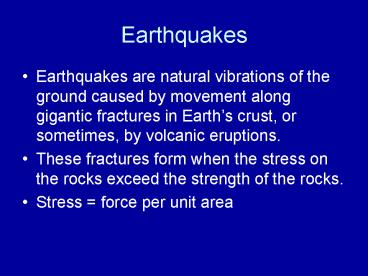Earthquakes - PowerPoint PPT Presentation
1 / 13
Title:
Earthquakes
Description:
Seismometer sensitive instrument that detects and records seismic waves. Seismogram record produced by a seismometer. Earthquakes. Travel-time curves ... – PowerPoint PPT presentation
Number of Views:296
Avg rating:3.0/5.0
Title: Earthquakes
1
Earthquakes
- Earthquakes are natural vibrations of the ground
caused by movement along gigantic fractures in
Earths crust, or sometimes, by volcanic
eruptions. - These fractures form when the stress on the rocks
exceed the strength of the rocks. - Stress force per unit area
2
Earthquakes
- Three types of stress that can act on Earths
rocks - Compression
- Stress that pushes a material together
- Tension
- Stress that pulls a material apart
- Shear
- Stress that causes a material to twist
3
Earthquakes
- Faults
- When stress between to rocks becomes too great or
is applied too quickly, a fracture is formed - This fracture or series of fractures, along which
movement occurs, is called a fault. - Fault plane
- The surface along which the movement takes place
4
Earthquakes
- Types of faults
- Reverse faults
- Fractures that form as a result of horizontal
compression - Normal faults
- Fractures that form as a result of horizontal
tension - Strike-slip faults
- Fractures caused by horizontal shear
5
Earthquakes
- Seismic waves
- The vibrations of the ground during an earthquake
- Types of seismic waves
- Primary waves
- Also called P-waves
- Squeeze and pull rocks in the same direction as
the wave is travelling - Travel through Earths interior
6
Earthquakes
- Secondary waves
- Also called S-waves
- Cause rocks to move at right angles to the
direction of the wave - Travel through Earths interior
- Surface waves
- Move in two directions as they pass through rock.
- Both up-and-down and side-to-side movement occurs
- Travel along Earths surface
7
Earthquakes
- Focus
- The origination point of an earthquake
- The point where the rocks suffer failure
- Epicenter
- Point on the Earths surface directly above the
focus.
8
Earthquakes
- Seismology the study of earthquake waves
- Seismometer sensitive instrument that detects
and records seismic waves - Seismogram record produced by a seismometer
9
Earthquakes
- Travel-time curves
- Over many years, the arrival times of seismic
waves from countless earthquakes at seismic
facilities all over the globe have been
collected. - Using this data, seismologists have been able to
construct global travel-time curves for the
initial P-waves and S-waves of an earthquake.
10
Earthquakes
- These general curves have provided the average
travel times of all seismic waves for different
distances, no matter where on Earth an earthquake
occurs. - P-waves always arrive first at a seismic facility
- With increasing travel distance, the separation
between P and S-waves increases. - Waves recorded on seismograms from more distant
facilities are farther apart
11
Earthquakes
- Measuring and locating earthquakes
- Magnitude
- The amount of energy released by an earthquake
- Richter Scale
- Devised by seismologist Charles Richter
- Based on the size of the largest seismic waves
generated by an earthquake - Each successive number represents an increase in
wave amplitude of a factor of 10
12
Earthquakes
- Energy vs. Size
- Each increase in magnitude (i.e. 8 to 9 on
Richter Scale) corresponds to about a 32-fold
increase in seismic energy - Example a magnitude 8 earthquake releases about
32 times more energy than a magnitude 7
earthquake and over 1000 times more energy than a
magnitude 6. - Moment magnitude scale
- Similar to Richter, but takes into account the
size of the fault rupture, amount of movement
along the fault, and the rocks stiffness.
13
Earthquakes
- Modified Mercalli scale
- A measurement of the amount of damage done by an
earthquake to the structures involved. - Uses Roman numerals to designate the degree of
intensity































